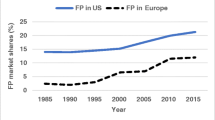Abstract
This paper analyzes the welfare implications of fixed-price regulation of services in a model in which consumers are heterogenous and a firm can endogenously quality discriminate. We consider two different scenarios: The first scenario is when the consumer is also the payer. The second scenario is when the payer (usually the government) is not the consumer. Our major result is that fixed-price regulation causes a distributional welfare loss. We show that it is not possible for fixed-price regulation to induce providers to supply all consumer types with the first-best quality even under perfect information, under either pricing scenario. We show that high and low demand types may receive more than their respective first-best qualities, less than their first-best qualities, or one type may receive more and the other type less depending on the level of the regulated price. It is always true that when consumers are payers, quality is higher for both types than when consumers are not the payers. In this paper, we motivate and discuss the results in terms of price regulation of hospitals where consumers are patients and patient types vary by severity of illness.
Similar content being viewed by others
References
Berki, S., M. Ashcraft, and W. Newbrander. 1984. “Length of Stay Variations within ICDA-8 Diagnosis Related Groups.” Medical Care 22:126–142.
Dranove, D. 1987. “Rate Setting by Diagnosis Related Groups.” The RAND Journal of Economics 18:417–427.
Dranove, D. and M. Satterthwaite. 1990. “Monopolistic Competition Where Price and Quality Are Most Perfectly Observable,” Working Paper, Kellogg School of Management, Northwestern University.
Ellis, R., and T. McGuire. 1986. “Provider Behavior under Prospective Payment: Cost Sharing and Supply.” Journal of Health Economics 5:129–151.
Friedman, B., and M. Pauly. 1981. “Cost Functions for a Service Firm with Variable Quantity and Stochastic Demand.” Review of Economics and Statistics, 53:620–624.
Harris, J. 1977. “The Internal Organization of Hospital.” The Bell Journal of Economics 8(2):467–482.
Horn, S. et al. 1985. “Inter-hospital Differences in Severity of Illness.” New England Journal of Medicine 313:325–333.
Horn, S. 1986. “Measuring Severity: How Sick is Sick? How Well is Well?” Healthcare Financial Management 40:21–31.
Newhouse, J. 1983. “Two Prospective Difficulties with Prospective Payment, or, Its Better to be a Resident than a Patient with a Complex Problem.” Journal of Health Economics 2:269–274.
Prospective Payment Assessment Commission. 1987. Report and Recommendations to the Secretary. Washington, DC: U.S. Department of Health and Human Services.
Schweiker, R. 1982. Report to Congress: Hospital Prospective Payment for Medicare. Washington, DC: U.S. Department of Health and Human Services.
Shleifer, A. 1985. “A Theory of Yardstick Competition.” RAND Journal of Economics 16:319–327.
Vladeck, B. 1984. “Medicare Payments to Diagnosis Related Groups.” Annals of Internal Medicine 100(4):576–590.
Author information
Authors and Affiliations
Rights and permissions
About this article
Cite this article
Allen, R., Gertler, P. Regulation and the provision of quality to heterogenous consumers: The case of prospective pricing of medical services. J Regul Econ 3, 361–375 (1991). https://doi.org/10.1007/BF00138477
Issue Date:
DOI: https://doi.org/10.1007/BF00138477




